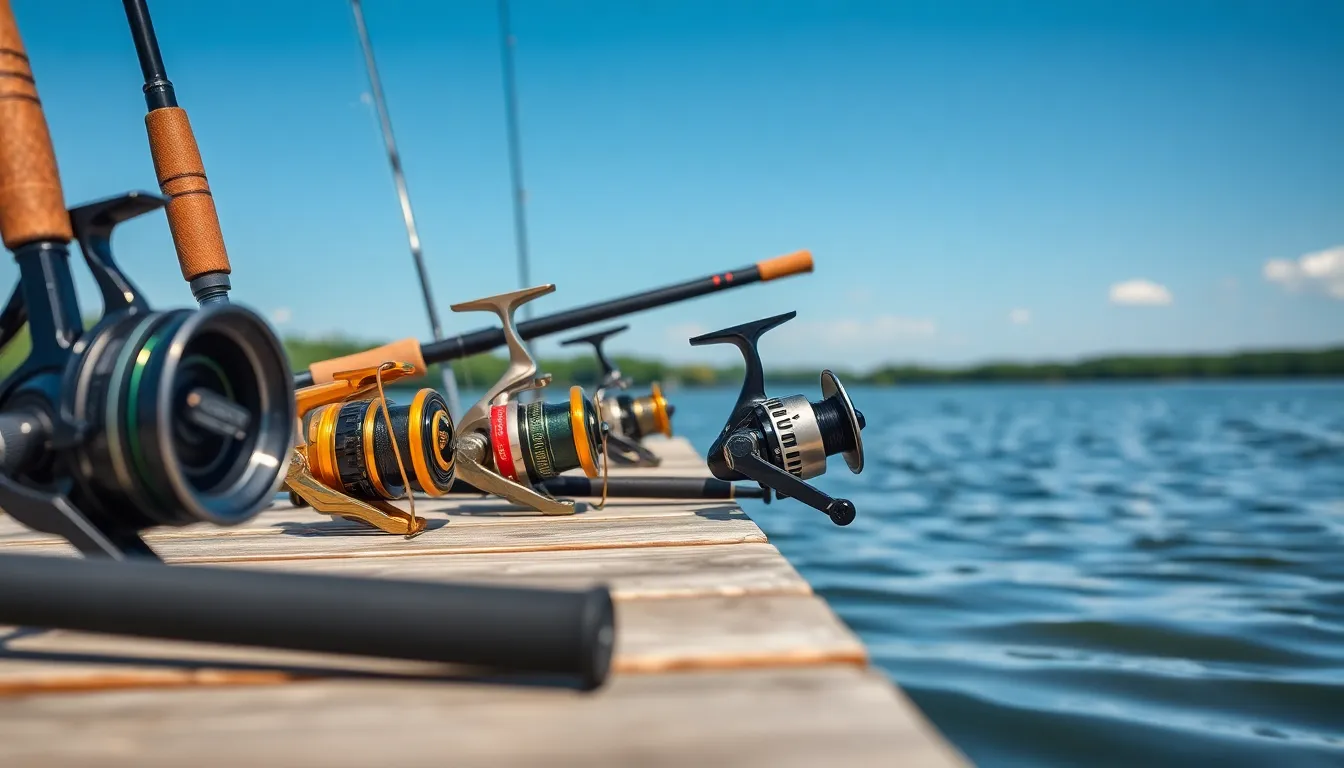Table of Contents
ToggleFishing isn’t just a hobby; it’s a way of life. Whether you’re casting a line from a tranquil shore or battling the waves on a boat, the right fishing gear can make or break your day on the water. Imagine reeling in that trophy fish while your buddies look on in awe. But without the right tools, you might as well be trying to catch a cold.
Overview of Fishing Gear
Fishing gear encompasses various tools and equipment essential for successful fishing. Having suitable gear significantly affects the overall experience and success rate, whether fishing from shore or a boat.
Types of Fishing Gear
Fishing gear typically includes rods, reels, hooks, and lines. Rods come in several types, such as spinning rods and baitcasting rods, each catering to specific fishing styles. Reels, including spin reels and fly reels, help in retrieving the line smoothly. Hooks vary in size and shape, designed specifically for different fish species. Lines, both monofilament and braided, offer unique strengths and sensitivities. Other essential gear includes tackle boxes, lures, and nets, which all contribute to a well-equipped fishing setup.
Importance of Choosing the Right Gear
Choosing the right fishing gear influences success and enjoyment. Proper gear ensures efficiency and enhances the comfort of the angler. Fish species, water conditions, and fishing techniques dictate gear selection. For instance, targeting larger fish demands stronger rods and lines. Additionally, the environmental impact should guide decisions on tackle types and materials. Anglers equipped with appropriate gear experience improved catch rates and greater satisfaction. Prioritizing quality equipment pays off during those memorable fishing trips.
Fishing Rods and Reels

Fishing rods and reels play a crucial role in ensuring a successful fishing experience. Selecting the right type can influence the overall comfort and efficiency of the angler.
Types of Fishing Rods
Casting rods offer versatility and are ideal for both freshwater and saltwater fishing. Spinning rods are easier for beginners, making them popular for light tackle. Fly rods, designed for fly fishing, provide flexibility for casting lightweight flies. Trolling rods suit those who fish from a moving boat, with added strength for larger catches. Finally, ice fishing rods are shorter, enabling anglers to fish in confined spaces.
Types of Fishing Reels
Spinning reels are the go-to choice for many anglers, known for their ease of use. Baitcasting reels provide better accuracy and control, suitable for experienced fishers targeting larger species. Fly reels are specifically designed for fly fishing, allowing for smooth line retrieval. Spincast reels combine features of both spinning and baitcasting reels, perfect for beginners seeking simplicity. Lastly, conventional reels excel in deep-sea fishing, handling heavier lines and larger fish effectively.
Fishing Tackle and Accessories
Fishing tackle and accessories play a vital role in successful fishing outings. Proper tackle ensures that anglers are well-equipped to attract and catch various fish species.
Baits and Lures
Baits and lures are crucial for enticing fish. Live bait, such as worms and minnows, mimics natural food sources, increasing catch rates. Artificial lures, including jigs and plugs, come in varying sizes and colors to attract different fish. Anglers often choose lures based on water conditions, weather, and targeted species. When fishing in freshwater, soft plastics provide versatility, while saltwater situations may require flashier options. Utilizing different baits can lead to more productive trips.
Hooks and Sinkers
Hooks and sinkers play significant roles in the fishing setup. Selecting the right hook size depends on the targeted fish species and bait type. Standard hooks, circle hooks, and treble hooks serve different purposes and improve hooking efficiency. Sinkers provide necessary weight to ensure baits reach desired depths quickly. They come in various styles, including split shots and egg sinkers, allowing anglers to adapt to different fishing environments. Understanding the dynamics of hook and sinker combinations enhances overall fishing effectiveness.
Fishing Line and Knots
Fishing lines play a crucial role in an angler’s success. Understanding the different types allows for better tackle choices suitable for various fishing scenarios.
Types of Fishing Line
Monofilament line offers versatility and ease of use, making it a popular choice among beginners. Fluorocarbon line, known for its invisibility underwater, excels in clear water conditions. Braid line provides exceptional strength and sensitivity, suitable for heavy cover and big game fishing. Each type has unique properties, catering to different fishing styles. Selecting the right line based on water clarity, species, and technique significantly enhances catch rates.
Essential Fishing Knots
Tying reliable knots is essential for securing hooks and lures effectively. The Palomar knot works well with both monofilament and braid lines, providing strength and reliability. The improved clinch knot offers simplicity and is perfect for attaching hooks swiftly. The loop knot allows for freedom of movement, ideal for certain lures. Learning these knots ensures better performance on the water, enhancing the angler’s overall experience.
Maintenance and Care of Fishing Gear
Proper maintenance extends the life of fishing gear. Cleaning rods and reels after each use prevents corrosion and buildup. Rinse saltwater gear with fresh water to remove salt residues. Dry gear thoroughly to avoid rusting, especially on metal parts.
Inspect lines regularly for abrasions and knots. Strong lines contribute to better catch rates. Replace any damaged line immediately to avoid breakage during fishing. Choose a fishing line appropriate for specific conditions to ensure optimal performance.
Store rods upright or in protective cases. Use soft cloths to wrap reels to prevent scratches and dust accumulation. Avoid placing gear in extreme temperatures, which can weaken components. Maintain tackle boxes by organizing lures, hooks, and sinkers to enhance efficiency during trips.
Lubricating reels periodically enhances functionality. Use specific lubricants recommended by manufacturers. Ensure proper tension on drag systems to improve line management during catches.
Check tackle and accessories for wear and tear. Dull hooks diminish effectiveness; replace them promptly. Examine lures and baits for signs of damage, ensuring they remain attractive to fish.
Lastly, use the correct knots when tying tackle components. Strong knots prevent disconnections during fishing adventures. Practice tying knots to build confidence, especially in challenging situations.
Investing in quality fishing gear is crucial for enhancing the overall fishing experience. With the right equipment tailored to specific fishing styles and conditions, anglers can significantly improve their success rates and enjoyment on the water. From selecting the appropriate rods and reels to understanding the importance of tackle and maintenance, every detail matters.
Proper care and attention to gear not only extend its lifespan but also ensure memorable fishing trips. By mastering the essentials of fishing equipment and techniques, anglers can fully embrace this rewarding lifestyle. Whether casting from the shore or navigating open waters, the right gear makes all the difference in achieving that thrilling catch.




